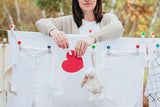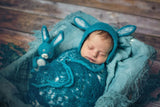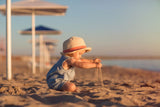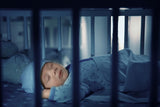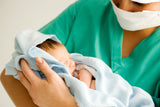Baby Clothes Checklist 0-3 Months
When it comes to making the baby clothes checklist 0-3 months for the family's newest addition, things can quickly get out of hand. Moreso, if you are a first-time parent, it is incredibly easy to get lost in the excitement and buy things your little one will not wear even once.
Before you decide to buy your little one a full wardrobe worth of clothes, take a step back and think about the essentials first. Making a list is the best way to decide what your baby needs. So let's see how your baby clothes checklist 0-3 months should look!

Source: shutterstock.com / Photo Contributor: Igisheva Maria
Baby Clothes Checklist 0-3 Months
Baby clothes are adorable, and it is easy to keep filling your basket with clothes you will never put on your little bundle of joy.
Plus, if you are having a baby girl, the clothing choices are endless, and even better, you can shop online. No need to tire yourself out browsing stores when you can find what you need and often at way more affordable prices from the comfort of your home.
For example, here at Bitsy Boutique, we have an excellent collection of newborn baby girl clothes. All you need to do is make a checklist of what you need and select them from the page.
The checklist for babies 0-3 months should look like this:
- Short-sleeved onesies
- Long-sleeved onesies
- Pajamas and sleepsuits
- Swaddler
- Knitted or sun hat
- Cardigans
- Scratch mittens
- Socks and booties
- Bibs
- Special occasion outfits
Short-sleeved onesies
Onesies are essential baby clothes. Your baby will wear onesies for the first three months, and you can also expect to be gifted several for your baby shower, so buying six to eight is a good place to start.
The number of onesies depends on how often you do laundry, but with a newborn, you are likely to wash their clothes daily. You should also expect to change your little one during the day due to sweating or spit-up accidents.
Short-sleeved onesies are excellent for the warmer months, and layering during the colder ones. Onesies are great as they will keep your bundle of joy covered even during nap time as they snap under the diaper.
Long-sleeved onesies
Long-sleeved onesies are a must if your baby is born or due to arrive during the colder months. They will keep your little one warm and covered even if they wriggle due to the snap feature.
Like short-sleeve onesies, you will also need six to eight long-sleeved ones. It is also a good idea to buy onesies in a bigger size as babies outgrow clothes fast, especially in the first months. Another reason for buying onesies in a bigger size is shrinkage. If you do laundry often, the onesies may shrink a size during the wash cycle.

Source: shutterstock.com / Photo Contributor: Elena Grigarchuk
Pajamas and sleepsuits
Sleepsuits have long sleeves and are simple to put on and take off because they have snaps at the front, legs, and crotch.
You will not have to change your baby's clothing when getting ready for a nap because sleepsuits are cozy to wear day and night and during naps. When buying pajamas and sleepsuits, three to six should suffice.
In general, you should look for the following when buying baby pajamas/sleepsuits:
- Look for pajamas with turnback cuffs (built-in scratch mitts) at the ends of the sleeves. They can be folded over to stop your baby from scratching their face.
- Avoid wearing sleepwear with snaps on the back as they can be difficult to change out of and uncomfortable to lay on.
- Instead of getting pajamas with button snaps, you can also look for zipper sleepsuits. Zippers allow you to change your baby faster as they are simpler to undo than button snaps.
- For the warmer months, look for sleepsuits made of cotton, and for the colder months, fleece.
- If your baby has sensitive skin, ensure the sleepsuits are made of 100% cotton material to avoid irritation to the little one's skin.
Swaddler
Many newborn babies miss the comfort of their mother's womb, especially in the transitional period after birth or the first three months.
One excellent way to provide this comfort for your newborn is by swaddling them, meaning wrapping them tightly with a swaddling blanket (swaddler). You can get five or six swaddlers, and you can use them for more than swaddling, like the following:
- burping cloth
- nursing cover
- changing pad cover
- car seat or stroller cover
Swaddlers provide babies extra comfort but remember to ensure the hips are loose when swaddling your newborn. You should stop swaddling when your baby starts rolling over, which happens around three to four months.

Source: shutterstock.com / Photo Contributor: Netrun78
Knitted or sun hat
While indoors, there is no need for your baby to have a hat on, but when outside, it is smart to cover the baby's head as protection from the sun or the cold. Having one or two hats suitable for the weather during the first three months is enough.
The hat will protect your baby's head from the sun's UV rays or the cold when you leave the hospital, during doctor visits, or for walks. You can buy a knitted hat if the weather is colder and a sun hat for warmer temperatures.
Cardigans
Cardigans or jackets are an excellent way to add an extra layer in case the weather gets chilly, as they are also easy to remove once the baby is warm enough. Buying around three cardigans should be enough for the first three months.
If you want the cardigans to last your baby longer, you can buy a size or two bigger and roll up the sleeves when you put them on the little one. Buying a bigger cardigan or jacket means your baby can wear it even after three months.
Scratch mittens
Scratch mittens are not only an excellent way to keep your baby's hands warm and cozy but also to keep them from scratching their face. Baby nails are sharp and grow fast, so they will likely regrow fast even if you clip them regularly.
Newborns are pretty fussy, so there is a big chance your little one will scratch their face without mittens. Buying one to three pairs of scratch mittens will be enough.

Source: shutterstock.com / Photo Contributor: Africa Studio
Socks and booties
You don’t need socks if the baby is dressed in footed sleepers or if the weather is warm. You may have to buy socks when you start wearing your infant in other clothes. Three to four pairs of socks should be plenty to start with.
However, you could have trouble keeping the socks on your baby's tiny feet. Your baby may be kicking the socks off, but you can fix this by getting them booties instead of socks.
If the temperatures where you live are warmer, then you do not need to add socks to your checklist. They can wait until the baby is older.
Bibs
Even though your baby is far from eating solids in the first three months, you should still buy bibs. Bibs are useful in keeping your baby's clothes clean, especially if they drool or spit often.
You should get eight to ten bibs, as they are likely to be the piece of fabric your baby dirties most often. Bibs are incredibly convenient as you can replace them with another if your baby spits up without changing their clothes.
With bibs, there is no need for clean up, meaning overtired parents will not need to stress about another thing.
Special occasion outfits
If you’re visiting grandma and grandpa, attending a wedding or a family celebration, or there are holidays during the baby's first three months, you will want to dress them up in a cute outfit. After all, is there anything cuter than a baby dressed in an adorable outfit?
You can buy one or two special occasion outfits, as you are unlikely to have the energy or wish to attend many events during the first three months after birth.
Plus, it's not like babies care about repeating outfits. In reality, whatever outfit you put your little one in, everyone is guaranteed to coo over them.

Source: shutterstock.com / Photo Contributor: Lithiumphoto
How Do Baby Clothes Sizes Work?
In reality, baby clothes sizes do not always correspond to a baby's age, meaning clothes labeled 0-3 months may not fit your child. Buying clothes before your baby is born is even more challenging, as you will not know the best size for them until they arrive.
It may be better to hold off on buying clothes until after the little one is born. For example, if your baby weighs 6 pounds, sizes 0 to 3 will be too little for them. Buying baby clothes based on your child's weight rather than age is best.
If you buy baby clothes before giving birth, save the tags, packaging, and receipts so you can return them if they don’t fit your baby. Also, keep in mind that you do not need to buy too many pieces of clothing for the first three months.
You will need to get larger clothing before you realize it because kids grow quickly and outgrow their garments, especially newborns. If you purchase too much infant clothing, your baby may outgrow them before you even get the chance to dress the baby in them.
Average baby clothes sizing based on age
- Preemie (P) - Up to 5 pounds.
- Newborn (NB) - From 5 to 8 pounds.
- 3 Months - From 8 to 12 pounds.
- 6 Months - From 12 to 16 pounds.
- 9 Months - From 16 to 20 pounds.
- 12 Months - From 20 to 24 pounds.
- 18 Months - From 24 to 28 pounds.
- 24 Months - From 28 to 30 pounds.
- 2T - From 29 to 32 pounds.
- 3T - From 32 to 35 pounds.
- 4T - From 35 to 39 pounds.
- 5T - From 39 to 43 pounds.
Tips on choosing baby clothes
- Get onesies and sleepsuits in white or other light colors. Buying clothes in the same colors will allow you to spend less time separating light and dark colors by putting them all in the same wash.
- When choosing colors for sleepwear and bodysuits, try to avoid gender-specific colors if you do not yet know the gender of your baby. Additionally, with non-gendered colors, you can reuse the clothes and save money if you have another baby.
- Before buying, read the labels on the clothing. Make sure everything you buy can be machine washed. Hand washing baby clothes will take up time that you will likely not have to spare. Furthermore, you should not add to the stress of looking after your baby when you can simply choose fabric suitable for machine washing.
- Avoid giving your child clothes with ribbons or ties. They are unneeded and are a choking hazard. Keep clothes with ties and ribbons for when your child is older. After all, safety comes first.
Choose easy-to-put-on and take-off baby clothes
When you are purchasing the clothes from your baby clothes checklist 0-3 months, ensure that the pieces you choose are easy to take off and put on.
Dressing a newborn is already hard enough due to all the wriggling. You do not want your little one to feel stressed out when you are dressing them for the day. In order to make dressing your newborn easier, consider the following:
- You should buy clothes with wide necks or neck snaps for easier dressing. If you buy clothes that need to be pulled over the baby's head, remember to do it as fast as possible while being gentle. This is because newborns tend to panic when their view is obscured or when they feel like their breathing is blocked.
- When buying baby clothes with snaps and zippers, choose clothes where they are placed in the front and not the back. Clothes with front zippers and snaps are easier to remove and put on than on the back.
- Make sure the sleeves on the baby clothes are loose and not tight. Tight sleeves are more challenging to take off.
- The onesies and sleepsuits you buy should have snaps or other easy openings at the crotch so you can change your baby's diaper faster without removing them completely.

Source: shutterstock.com / Photo Contributor: Mitina Asya
Conclusion
In conclusion, these are the essentials you need to put on your baby clothes checklist 0-3 months. Of course, if anything catches your eye, it is okay to indulge as long as you don’t overdo it and end up with piles of unused baby clothes.


